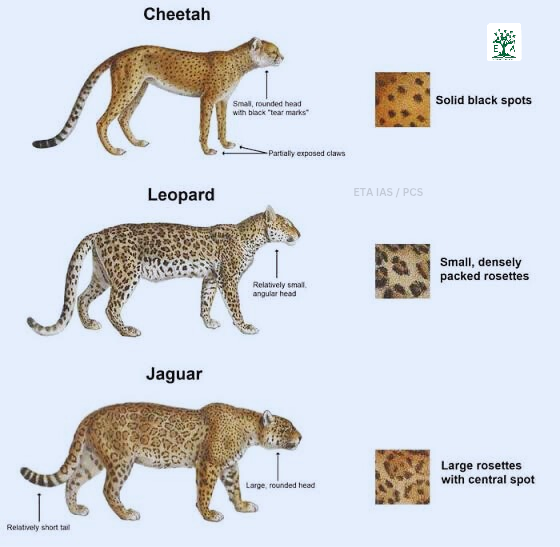The translocation of African cheetahs to India has presented several significant challenges, including:
High Mortality Rate:
- A concerning mortality rate of 40%-50% during the initial phase of the project, significantly lower than the expected survival rate of 85%.
Increased Stress Levels:
- Over 90 instances of chemical immobilization and frequent veterinary interventions suggest elevated stress among the cheetahs.
- Ongoing concerns about their physical and mental well-being.
Ethical and Ecological Concerns:
- The project’s dependence on a steady influx of cheetahs from southern Africa raises ethical and ecological sustainability issues.
- The African cheetah population is already under threat, with approximately 6,500 mature individuals remaining in the wild.
Long-Term Feasibility Doubts:
- These challenges contribute to skepticism about the scientific justification and long-term feasibility of Project Cheetah in India.
Project Cheetah Overview:
- Aimed at reintroducing cheetahs into their natural habitat after their extinction in India in 1952.
- Led by the National Tiger Conservation Authority (NTCA).
- The Wildlife Institute of India (WII) provides technical support and coordination for the reintroduction process.
Reintroduction Efforts:
- 20 adult African cheetahs introduced into Kuno National Park (KNP) in Madhya Pradesh:
- 8 cheetahs from Namibia in September 2022.
- 12 cheetahs from South Africa in February 2023.
- As of February 2025, 26 cheetahs are surviving, comprising 12 adults and 14 cubs.
- Several adult cheetahs have died due to causes such as starvation and bacterial infections from injuries related to tracking radio collars.
- 20 adult African cheetahs introduced into Kuno National Park (KNP) in Madhya Pradesh:
Future Plans:
- The government plans to relocate an additional group of cheetahs from Africa to the Gandhi Sagar Wildlife Sanctuary in Madhya Pradesh, as part of the Cheetah Action Plan.
Cheetah Characteristics:
- Recognized as the fastest land animal in the world.
- Features a slender physique, elongated legs, small rounded head, and unique black spots on tan fur.
- A carnivorous animal, primarily preying on small to medium-sized antelopes like gazelles and impalas.
Habitat:
- Cheetahs inhabit various environments, including scrub forests, dry grasslands, savannas, and other arid or semi-arid open areas.

Distribution of Cheetahs:
- Historically, Asiatic Cheetahs had a wide distribution across India, ranging from:
- Punjab to southern Tamil Nadu.
- Gujarat, Rajasthan, and Bengal.
- In 1952, cheetahs were officially declared extinct in India.
- Historically, Asiatic Cheetahs had a wide distribution across India, ranging from:
Current Subspecies Distribution:
- Four subspecies of cheetahs are recognized today.
- These subspecies are native to Africa and Central Iran.
- Present in fragmented habitats in:
- Iran
- Sahara Desert
- Tanzania
- Namibia
- South Africa, among others.
Threats and Conservation Status:
- Threats:
- Habitat loss
- Conflict with humans
- Poaching
- High susceptibility to diseases
- Protection Status:
- IUCN Status: Vulnerable
- CITES: Appendix I
- Wildlife (Protection) Act 1972: Schedule I
- Threats:
Cheetah Conservation Fund:
- Founded in 1990 as an international non-profit organization.
- Headquartered in Namibia.
- Focused on the conservation of cheetahs and their ecosystems.
Significance of Conserving Keystone Species:
- Cheetahs as Keystone Species:
- Cheetahs have been reintroduced in India due to their ecological and economic significance.
- Keystone species play a critical role in maintaining ecosystem stability and function.
- They shape ecosystems in various ways, such as being apex predators or ecosystem engineers.
- Without them, ecosystems could dramatically change or cease to exist.
- A keystone species is often a predator, but not always (e.g., cheetahs, wolves, sea otters).
- Cheetahs as Keystone Species:
Importance of Keystone Species Conservation:
- Restores Degraded Ecosystems:
- Many keystone species are at the top of the food chain and regulate prey populations.
- This helps reduce pressure on ecosystems and maintains balance.
- Example: Cheetahs help restore open forest and grassland ecosystems.
- Biodiversity:
- Keystone species prevent lower trophic level species from monopolizing critical resources.
- This ensures multiple species can survive by controlling competition for space and food.
- Example: Sea otters control sea urchin populations, reducing pressure on kelp forests that support diverse fish species.
- Ecosystem Services:
- Conservation of keystone species is economically beneficial by ensuring vital ecosystem services.
- Example: A report by IIFM shows that every rupee spent on tiger conservation yields ₹2500 in returns from ecosystem services like water provisioning, soil conservation, gene pool protection, and tourism.
- Restores Degraded Ecosystems:
Project Cheetah’s Role in Conservation:
- By revisiting India’s conservation ethos, Project Cheetah aims to restore the lost presence of cheetahs.
- This contributes to the country’s biodiversity and ecological balance.
Question: Which of the following statements is true regarding the reintroduction of cheetahs in India?
A) Cheetahs were declared extinct in India in 1952 due to excessive hunting and habitat loss.
B) In 2022, India successfully reintroduced cheetahs from Africa into the Kuno National Park in Madhya Pradesh.
C) The cheetahs in India are the same species as those found in Africa.
D) India has the largest population of cheetahs in the world.
